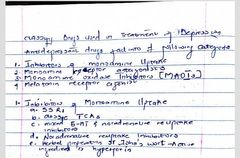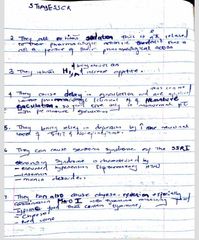![]()
![]()
![]()
Use LEFT and RIGHT arrow keys to navigate between flashcards;
Use UP and DOWN arrow keys to flip the card;
H to show hint;
A reads text to speech;
20 Cards in this Set
- Front
- Back
|
Depression is governed by |
Monoamine theory of depression |
|
|
...... is the most common of the affective disorder |
Depression |
|
|
Monoamine theory 1.was proposed by 2. State it |
1. Schildkraut, 1965 2. State that, decrease in neural level of serotonin and / or Noradrenaline results in depression, Whereas, increase in neuronal level of Noradrenaline and / or serotonin results in mania.. |
|
|
List the affective disorder |
Are disorders of mood.. 1. Depression 2. Mania |
|
|
Depression - |
Is a feeling of being moody, or apathy., lack of interest in most things that are natural. A feeling of ugliness, not being wanted, and an attempt to suicide.. Depression symptoms include 1. Emotional symptoms 2. Biological symptoms. |
|
|
Depression can be divided into? |
1. Unipolar depression ( sometimes called reactive depression) 75% 2. Bipolar depression ( 25% ) |
|
|
Classify anti depressants |

Dr. Azikiwe' way 1. Classical / typical antidepressants 2. Non-classical / atypical antidepressants |
|
|
Classic Vs non classical antidepressants |
1.Classical / typical antidepressants - obey the monoamine theory of depression in their MOA 2. Non-classical antidepressants - a drug used in treatment of depression that bring about relief in depression but do not necessarily obey the monoamine theory of depression in their MOA.. |
|
|
Lit the features of classical anti depressants |

1. They exhibit therapeutic delay. |
|
|
Monoamine theory of depression is also called? |
Biogenic amine theory |
|
|
About SSRIs 1. List examples 2. MOA 3. |
H |
|
|
Escitalopram is |
Is the pure S- enantiomer of Citalopram |
|
|
List SNRIs |
1. Venlafaxine 2. Desvenlafaxine 3. Duloxetine 4. Levomilnacipran |
|
|
Venlafaxine vd Desvenlafaxine |
Desvenlafaxine is the active, demethylated metabolite of Venlafaxine.. |
|
|
Pharmacology of Venlafaxine and Desvenlafaxine S/E |
Nausea, headache, sexual dysfunction, dizziness, insomnia, sedation, constipation |
|
|
About Duloxetine 1. Class of drug 2. S/E 3. C/i 4. |
1. SNRIs 2. GI - nausea, dry mouth and constipation.. Insomnia, dizziness, somnolence, sweating, sexual dysfunction.. 3. Liver dysfunction |
|
|
Levomilnacipran 1. Chemistry 2. Metab |
1. Levomilnacipran - is an enantiomer of milnacipran.. 2. Metab. By CYP 3A4.. |
|
|
Prototype SSRIs |
Fluoxetine |
|
|
SSRIs are most favorite in Rx of |
Premature ejaculation |
|
|
A.E of SSRIs |
1. Headache, sweating, anxiety and agitation 2. GIT disturbances ( n, v, d) 3. Weakness and fatigue 4. Sexual dysfunction( loss of libido, delayed ejaculation, anorgasmia) changes in weight 5. Sleep disturbance ( insomnia and somnolence) 6. Hyponatremia esp in elderly and patient who are volume deplected or taking diuretics |

